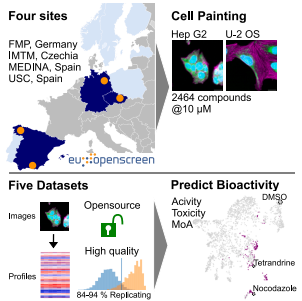Newsroom
EU-OPENSCREEN Consortium Releases First Open-Source Cell Painting Dataset

Graphical abstract from Wolff et al., 2025
Cell Painting is a powerful imaging-based approach that allows researchers to rapidly observe cellular changes in response to controlled perturbations. Following an extensive protocol optimisation process, four EU-OPENSCREEN screening platforms have successfully generated their first Cell Painting dataset using two common cell lines. To collect these data, the consortium treated these cell lines with a subset of compounds from the European Chemical Biology Library (ECBL), all with known biological activities. In-depth analysis confirms the dataset’s high quality and robustness, which is comparable to other published Cell Painting datasets.
The data captured with this method, which links changes in cell morphology to drug applications, are openly available to the scientific community under the FAIR (Findable, Accessible, Interoperable, and Reusable) principles. The dataset represents a valuable resource to develop innovative AI-driven methods for drug discovery and will help to accelerate the development of novel medication.
In 2025, the consortium will generate further Cell Painting datasets using over 100,000 compounds from the EU-OPENSCREEN collections. This initiative will yield one of the largest open-source Cell Painting datasets available to the scientific community, further supporting global research in drug discovery, toxicology, and molecular phenotyping of diseases.
The consortium comprises the Leibniz Institute for Molecular Pharmacology (Germany), Fundación MEDINA (Spain), the Institute of Molecular and Translational Medicine at Palacký University Olomouc (Czechia), and the University of Santiago de Compostela (Spain). All consortium members are accredited partner sites in EU-OPENSCREEN, the European Research Infrastructure Consortium (ERIC) for chemical biology and early drug discovery.
To learn more, see the consortium’s recent publication in iScience:
Morphological profiling data resource enables prediction of chemical compound properties
Wolff, Christopher et al.
iScience, Volume 28, Issue 5, 112445
https://doi.org/10.1016/j.isci.2025.112445
Or contact Dr. Christopher Schmied (Schmied@fmp-berlin.de) (lead author), Dr. Han Sun (hsun@fmp-berlin.de), or Dr Jens von Kries (Kries@fmp-berlin.de).